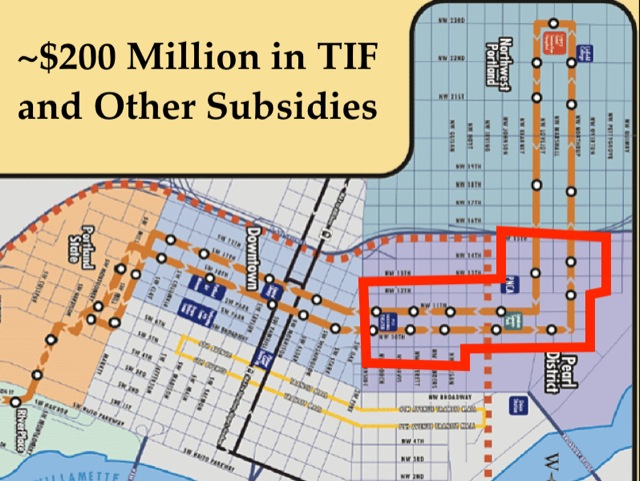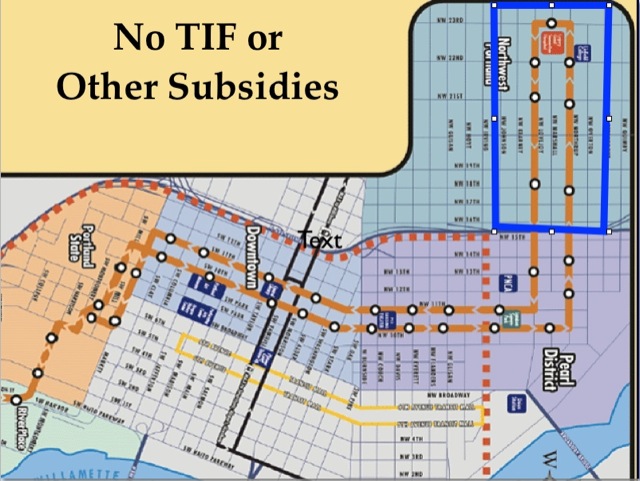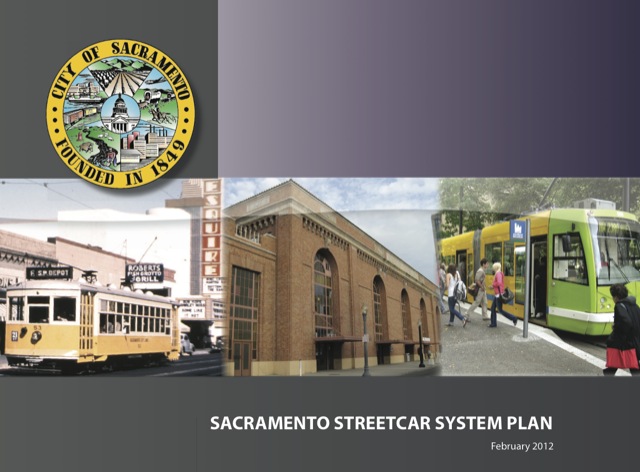Another day; another city getting scammed by the streetcar mafia. In this case, it is Sacramento, a city that has built 37 miles of light-rail lines and seen transit’s share of commuting fall from 4.1 percent in 1980, before light rail, to 3.2 percent in 2010.
In 2006, Sacramento’s metropolitan transportation plan admitted that, despite past plans focusing on “luring drivers out of their autos,” the share of transit riders was decreasing; and despite building no new roads and seeing huge increases in congestion, the amount of auto driving had doubled since 1980 (see page 3). So naturally, the plan recommended more of the same.
Apparently, that still didn’t work, because now they want to try something new. Since light rail wasn’t fixing any problems, they want to build 18 miles of streetcar lines costing $816 million, or $45 million a mile. The plan calls for a $125-$135 million “starter line” of 2.55 miles that will also share 0.75 miles of rails with light rail, reducing the light-rail line’s capacity to move people, which isn’t an issue because so few people ride the light rail.
Of course, the justification for building the line is the billions of dollars of new economic development that will supposedly result. “Over the past decade since the Portland Streetcar line was opened in 2001, more than $3.5 billion in private investment has occurred along this route.”
In fact, at least 10 percent of it was a state university, so was hardly private. As for the private part, as the Antiplanner has previously noted, almost all such “private investment” was publicly subsidized. Moreover, on the parts of the streetcar route that had no subsidies, there was almost no new development.

Here’s a map of the streetcar route showing the portion of the Pearl District that was within two blocks of the streetcar. This area received more than $200 million in tax-increment financing and other subsidies.

Here’s the same map highlighting the portion of the streetcar route in Northwest Portland that was outside of any urban renewal district. This area received no subsidies.
Most medicines available for enhancing sexual performance are prescription based totally, so you need to consult a physician before using commander cialis as some people can be at high risk by using cialis, a good example is people that are undergoing treatment for hypertension. Until recently, psychological problems were thought to be the only cause of infertility in approximately 30% of couples and a contributing factor in another 20% to 30%. cialis canada cheap levitra 40mg Is Super P Force Safe for Consumption? Super P Force is perfectly safe for the treatment of erectile dysfunction. Treating erectile dysfunction was never so easy but after when kamagra introduced in the market, ED is no longer viagra for women the only factor that is responsible for declining the sexual performance in men.
According to Portland’s report on the streetcar and economic development, the area in the Pearl District saw $1.3 billion in private investment in more than 50 developments averaging about $27 million per development. By comparison, the second area saw a mere $17 million in seven developments (at least one of which has since gone bankrupt), an average of just $2.5 million per project. So: was it the streetcar or the TIF and other subsidies that generated the development?
When the Antiplanner pointed this out in a Cato Institute report, the head of Portland’s streetcar program, Rick Gustafson, responded to “lies and misleading statements by Cato Institute” by saying, “Streetcar is not the sole cause of economic development. The best approach is a comprehensive set of strategies.” In other words, the Antiplanner was absolutely correct that streetcars alone won’t lead to economic development.
If economic development is the goal (and, arguably, it shouldn’t be a goal of government), then the best approach is the most cost-effective set of strategies. How does the streetcar rate on a cost-effectiveness scale?
This question never gets asked in reports such as the Sacramento streetcar plan. Instead, the plans all imply that Portland did nothing but build a streetcar and got economic development. It is these reports that are full of lies and misleading statements.
The problem is especially acute in California, which repealed the law giving cities the authority to use tax-increment financing to subsidize development. Since the streetcar alone isn’t going to stimulate development, how will Sacramento fund the “comprehensive set of strategies” that Gustafson alludes to?
One answer comes from Arizona, the only other state that doesn’t allow tax-increment financing. Mesa is subsidizing housing along a light-rail line using federal tax credits. Those tax credits could be used anywhere, but Mesa is concentrating them on the light-rail line, after which it will no doubt say, “Look! We built a light-rail line and got all this new housing.”
As I’ve said before, streetcars are an urban intelligence test. They are slow. Oregonian reporter Joseph Rose decided to test the “urban myth” that Portland’s streetcar is slower than walking and discovered, “It’s no myth. You can walk faster than the streetcar to your destination.”
Streetcars are low-capacity transit, capable of moving only a few thousand people per hour. Buses can move far more people because buses can safely travel a minute or so apart while streetcars must be spaced at least three minutes apart. Streetcars actually increase urban congestion because they occupy a lane of traffic, stop frequently, and take few if any cars off the road.
Most important, streetcars are expensive. Not only is their capital cost high, they cost twice as much to operate as buses and impose high long-run maintenance costs as well–costs that never get considered in any streetcar analysis. The Sacramento plan says, for example, that it will cost $4 million per year to operate and maintain the streetcar, but says nothing about replacing worn-out tracks, wires, vehicles, and other infrastructure after 25 or so years.
Anyone who think that it is worth spending more than $100 million on a 7-mph clunker of a streetcar line fails the intelligence test. Of course, someone will make a lot of money building the line, so they will no doubt lobby for it. Unfortunately, a lot of other people will get sucked into the plan by a combination of nostalgia and misleading claims about economic development. The losers will be taxpayers and travelers.









I know this is off topic, I don’t care…
In response to the national priority regarding restrictions of firearms and the worries regarding states rights; several companies have ceased (or will cease) the sale of firearms, ammunition and accessories to law enforcement agencies in states with the most intrusive laws restricting specific guns and magazine size; in particular, California and New York specifically. This is going to be very interesting. I suppose when enough cops are dead due to aging or poor equipment, the lawmakers will reconsider……assuming they care or enough companies jump on the band wagon. Even the foreign makers like Glock, SIG, Beretta or Heckler & Koch have models built here and I don’t think they’ll take to kindly to it either cause the American consumer is their bread and butter. Olympic Arms has announced it will no longer be doing business in New York state at all in response to the proposed gun laws. Barrett Firearms has stated it will no longer service or sell it’s products in California. If a California police department or government employee sends them a weapon for service they will NOT return it. Their feeling is if such a weapon that’s far to cumbersome and heavy to use in a typical crime is illegal for public citizens, it should be illegal for everyone else regardless of whether they have a badge or not. York Arms has shipped it’s orders to states close by so New York residents can complete their orders and terminated any Law Enforcement / Government orders outright. LaRue Tactical of Texas has announced it will apply all current Federal, State and Local Laws (as applied to civilians) to state and local law enforcement / government agencies. Online firearm and accessorie retailer Cheaper Than Dirt stepped up with a statement on their Facebook page adopting the policy to not to sell prohibited items to government agencies and/or agents in states, counties, cities, and municipalities that have enacted restrictive gun control laws against their citizens. Ammunition makers have followed; however measured success depends on the makers with Remington and Hornady being two of the largest which begs the question of the recent government order of a billion additional rounds under contract. The largest provider of ammunition to the federal government is Alliant Tech Systems with rounds as small as 9mm to as large as……well.
http://www.youtube.com/watch?v=D9yCURHiwBQ
Analysts expect more firms to follow suit. While the big three handgun makers to law enforcement; Glock, Smith & Wesson, and Sig Sauer have not come on board, Freedom Outpost, the NRA, as well as, Guns Save Lives and various others have encouraged them to do so. Our President believes that ordinary citizens do not need shotguns with more than 5 rounds, pistols with more than 10 or rifles with more than 10. The math is fuzzy as nearly all gun related murders are committed with handguns containing relatively few rounds. The number of rounds is irrelevant. In fact, the gun is irrelevant apparently, when someone decides to kill someone else, they prefer baseball bats, knives or choking the life out of them over guns. Under federal law a M203 40mm grenade launcher is classified as a destructive device but a Cobray 37 mm flare launcher whose mechanism and cycle of operation is virtually the exact same fashion is classified………a navigational aid.
As for the gun issue, I am largely pro-gun and I think the manufacturers’ ban on selling to certain states is just ridiculous. Boycotts almost never work, especially when they are punishing law enforcement for what the legislature does. Not a winning strategy. Even worse, it tries to make the gun issue a matter of who has the most power/leverage. State legislatures and Congress usually win those fights.
Back to the street car issue, I can’t believe that any city in California doesn’t have enough fiscal problems that it is looking to start a up a new one. Sacramento’s mayor is a former NBA player and the city is losing its NBA team to Seattle. If the federal government subsidies for sports stadiums were as generous as for pet train projects, then certainly Sacramento would spend the money elsewhere. But the whole purpose of heavy subsidies are to make stupid projects profitable to at least a few people.
As with other things that run on rails, I love streetcars.
Especially classic PCC cars.
But that does not mean that I am in favor of spending huge sums of public-sector dollars on this technology now, because I am not.
Are there any cities in the US without plans for trams?
O’Toole: This area received more than $200 million in tax-increment financing and other subsidies.
THWM: Strange thing is that you guys play the same type of games! :S
Thoreau Institute, Camp Sherman, Oregon
EIN (Tax ID): 510172752
Deductibility Code; Contributions are deductible.
….
Cato depends solely on tax-deductible contributions
C. P. Zilliacus February 19, 2013 at 6:58 am
As with other things that run on rails, I love
Especially classic PCC cars.
But that does not mean that I am in favor of spending huge sums of public-sector dollars on this technology now, because I am not.
THWM: Track is not expensive, also streetcar prices should not be much higher than that of a bus. It is dirty politics that have inflated the price tag, but you don’t admit that. >:(